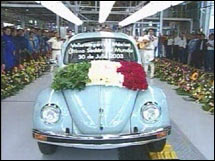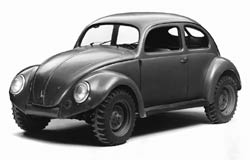NEW YORK (CNN/Money) -
Some Bugs are hard to kill. After a brief reprieve, the Volkswagen Beetle, the original version, faces extinction today. Volkswagen's plant in Mexico -- the only one in the world that still makes the old-style Beetle -- finishes one last gussied-up retro edition of the plucky, curvacious little car, ending the model's 70-year run.
 |
|
| The last "Ultima Edicion" Beetle rolls off the line. |
More than 21.5 million of the cars have hit the world's roads in that time. The last 3,000 old Beetles were special, dubbed the "Ultima Edicion." That's Spanish for "Final Edition." Basically, they were the good old Beetle, only a bit fancier. They were made in the colors Aquarius Blue and Harvest Moon beige and sported chrome trim and mirrors, body-colored rims and whitewall tires.
The Ultima Edicion Beetles cost 84,000 Mexican pesos at dealer lots -- about $8,000 -- compared to 68,000 pesos for the regular version that stopped production on July 10, or about $6,500.
The beloved Bug
From Iceland to Malaysia, the original Beetle has attracted devoted fans like no other car. A redesigned, sleeker version called the New Beetle was launched in 1998, but at a price of $20,000 to $25,000 it is no longer a car for anyone with a few bucks.
For the 300 Mexicans who work on the Beetle production line at the plant in the central Mexican state of Puebla, it will be like parting with a member of the family. The factory will continue producing the New Beetle.
In 1996, Mexico became the last country to produce the old Beetle and since 1998 the car has been sold only there. The Volkswagen plant in Puebla also is the only one worldwide to produce the New Beetle, but they are mainly for export.
In Mexico City, the bug, or "vocho" as it is known locally, is a stalwart. Painted white and green, it is the standard model used by taxi drivers to crawl through heavy traffic. A decision by Mexico City's local government to give out future permits only to taxis with four doors helped to seal the two-door bug's fate.
Dark beginnings
The car that became the VW Beetle originally was conceived by Hitler while he was imprisoned in 1924 after an attempted coup. He conceived of an inexpensive car that typical German families could buy. They could be driven along the sweeping highways that Hitler wanted to build across Germany.
In 1933, through a combination of backroom politics and murder, Hitler seized power in Germany. The following year, he gave the task of designing the car to Ferdinand Porsche.
By 1938, designs were completed, a factory site selected and Hitler announced the car's name: The KdF-Wagen. KdF stood for "Kraft durch Freude" or "strength through joy." The name never became widely used by the German public, though, said James Flammang, author of the book "Volkswagen: Beetles, Buses and Beyond." It was more commonly called the "Volkswagen," or "people's car."
As it turned out, though, no ordinary Germans ever got a Volkswagen while the Nazis were in power. By the outbreak of war in 1939, only about 630 cars had been built. Almost all of them went to German military officers and to Hitler himself.
 |
|
| World War II Kommandurwagen |
No Beetles, as they were later called, were built during the war. The car was used as the basis of various military vehicles, though. Among them were the amphibious Schwimmwagen, the jeep-like Kubelwagen and the Kommandurwagen which looked like a fat-tired Beetle 4x4.
The mechanical and electrical guts of some of those Volkswagen-based military vehicles were used to build the early Porsche 356 sports cars -- ancestors of the modern Porsche 911 -- said Chris Barber, author of the book "The Birth of the Beetle."
After World War II, under the jurisdiction of the British Military, production of the car, now named the Volkswagen, was restarted. By 1949 the car was being exported and two convertible versions, a 2-seater and a 4-seater, were available. Today, the 2-seater, made by a company called Hebmueller, is a valuable collectors' car.
 |
|
| Hebmueller convertible |
The chubby, curvy little car took off, quickly becoming a symbol of the German economic miracle. As its popularity spread, the Beetle became the car of choice of the rebellious post-war generation in the United States and Europe, for whom it represented freedom from the tight social restrictions of the time.
By 1955 1 million Volkswagens had been produced. A VW sedan -- the name "Beetle" didn't become official until the late 1960s -- cost about $1,500, according to the Web site Nadaguides.com. Subtle changes appeared in the car over time, including changes to the rear window and increases in engine size. VW introduced the slightly longer Super Beetle -- boasting more in the front "trunk" -- in 1971.
The last hard-top old Beetle was sold in the U.S. in 1977, costing about $3,700. That was a little more than the competing Ford Pinto. The last convertible was offered for sale in 1980 for about $6,500.
By that time, demand had ebbed in the face of more technologically advanced small cars. Also, the Beetle's air-cooled engine couldn't meet stringent U.S. air quality regulations, Flammang said.

-- Reuters contributed to this story.
|

